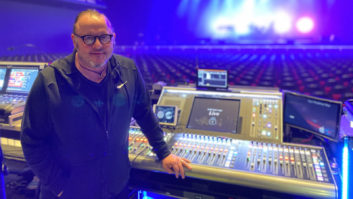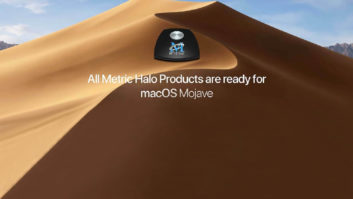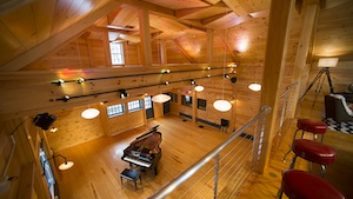
Producers and recording engineers recognize that only a handful ofdigital reverbs are worthy of the title “main reverb.”These are all great-sounding units that can adapt to any source, fromstrings and vocals to hard-sounding drums and percussion. Despite theTC Electronic Reverb 4000’s diminutive physical size (its aluminum andsteel chassis is just 1U and 8½ inches deep), it belongs in thatrarified class because it is a single-DSP engine version of TC’sflagship System 6000. After using the Reverb 4000 during a month-longalbum-mixing project, I found it consistently proved itself on everysong as a first-class, no-compromise main reverb.
Strictly a digital reverb (no phasers, flangers, chorus, delays,pitch-related effects, EQ or dynamics), the 4000 comes with 150 stereopresets pulled from TC’s 6000, M5000 and M3000 units, along withclassic reverb emulations such as EMT 140 plates, EMT 250 and AMSNonLin. There are 100 additional memory locations for user-modifiedpresets and another 100 can be held on a PCMCIA card (front-panelslot). The unit comes with editor software on a CD-ROM that, via a USBconnection, turns any PC (Mac in late 2003) into a virtual version ofthe TC ICON remote controller: a hardware unit controlling the System6000 and DB-8. Although using the 4000 with the ICON in the studio isgreat with every section and parameter quickly accessible onbeautifully designed pages, the Reverb 4000 functions the same as astand-alone unit, with all salient parameters available on theeasy-to-learn and use front-panel interface.
The user interface design is very intuitive and immediate; ingeneral, push a button, enter a short menu screen and adjust parameterswith the large encoder wheel. The front-panel display is tiny and hasLEDs for L/R input-level meters, overload, sample rate, MIDIprogramming and Preset Editing mode. The 56×128-dot graphic LCDshows which preset is running, as well as submenus for Recall, Store,Utility and Wizard functions.
TC TECHNICAL AND MENUS
The Reverb 4000 uses 24-bit AD/DA converters running at 44.1 or 48kHz, 88.2 or 96 kHz in double-rate mode. Both A/D and D/A convertersrun at 6.144 MHz using delta-sigma conversion at 48/96 kHz. In additionto balanced XLR inputs and outputs, there are AES/EBU and S/PDIFdigital I/O connections, as well as Tos-link/ADAT Lightpipe sockets anda Word Clock/Sync Input RCA connector.
The I/O menu lets you select between digital or analog I/O, clocksource, analog and digital level trim (24-bit transparent at 0 dB),ADAT routing and output dither. Peak analog levels default to ±18dBU (12 dB of headroom) and are adjustable from -11 dBU to ±21dBU. There are no hardware front-panel input/output level or wet/drymix pots. Wet/dry mixing takes place internally, and the Reverb 4000’sinternal signal path uses 48-bit double-precision processing. I triedthe unit using both the analog and digital I/O and could not tell anysonic difference in the reverb sound or the dry-source audio.
Live sound mixers will like the Kill Dry feature: When Bypass ispushed, you have the choice (in the I/O menu) of hearing the reverbtail continue or not. Finally, the Utility menu is for MIDI parametersetup, memory copying and card formatting.
TC ALGORITHMS
The Reverb 4000 uses only algorithms developed by TC Electronic, andeach preset’s unique set of parameters is fully adjustable. The manualprovides good explanations, so you can edit with confidence andpurpose. Algorithms include VSS-4, a true stereo reverb that, accordingto TC, is based on “source-related reflections from multipleangles…comparable to real-world mono or stereo sources positionedin an authentic or virtual space”; VSS-3, a multipurposealgorithm from the M3000 with many adjustable parameters in the earlyreflection, reverb diffusion and modulation sections; NonLin-2, aneffect reverb with adjustable attack, hold and release; DVR-2 (the EMT250 emulator), a generic reverb; Reverb 4, a very adjustable roomambience; VSS-4TS, another true-stereo reverb that utilizes two linkedreverbs; and Ambiator, which provides many simulated acousticenvironments. The latter, along with NonLin-2, are mostly used in theEffects bank presets.
SELECTION, ORGANIZING AND THE WIZARD
Memory locations are arranged in four contiguous banks: halls,rooms, plates and effects. Without using the ICON software, scrollingthrough presets is a little tedious with the wheel, as there is nodirect-access keypad to access a specific preset. You can skip throughbanks with the Up/Down buttons and then scroll to the preset.Thoughtfully, TC has added the Recall Wizard feature, a kind of searchengine or filter to find factory-recommended reverb presets. Searchengine results are determined by the preset’s origin (where itoriginally came from), size (micro, small, medium, large or extra-largeacoustical spaces) and source (what the reverb is going to be on). Inaddition to new users of the 4000, this is the perfect feature foranyone who wants some type of ambience treatment but doesn’t know whichpreset to start with (or just wants to explore). Search results can beselected with the wheel or listed on the ICON’s main screen.
MODIFYING AND STORING
Modifying presets is very simple: Three dedicated front-panel knobcontrollers adjust the three most important parameters of any preset,usually (except for NonLin-2 and Ambiator) predelay time, decay timeand a high-frequency parameter, such as roll-off, coloration or decay.Once a preset is recalled, the Up/Down keys move you through successiveand lesser-important trios of parameters that are also adjustable bythe same three knobs. Along with the selected preset, these threeparameters remain current and running; they are always visible at thebottom of the display even when you browse to have a look at otherpresets. There is a helpful flashing Recall/Enter reminder in thedisplay when you are not looking at the currently running reverb’sparameter menu. If you get lost in the wilderness of parameters, pushthe Home button and you are automatically backed out to the root page;i.e., the initial page that comes up when you first selected thepreset. Using the ICON after selecting a preset, you’ll get a row ofsix virtual-parameter sliders: the previously mentioned first three andthe next lower level’s three.
Once you’ve selected and tweaked a preset to your needs, you canrename it and store it. I liked that the 4000 defaults to the next freeuser-memory location and stores it using the original preset’s name ifyou don’t rename it yourself. You can store at any time if you want totry different parameter settings of the same preset and A/B betweenthem. Toggling between presets has a momentary lapse of one to twoseconds when loading a new preset. I could not find a way to compare myparameter changes to the original factory settings other than to storeboth versions in two user-memory locations and switch between them.
VIRTUAL ICON CONTROLLER SOFTWARE EDITOR
I installed the included ICON software editor in my 800MHz CeleronPC. Installation went fine, although at a later date, I had toreinstall the software for some strange Microsoft XP Pro reason, Ithink. When you connect the USB cable to the 4000, the software detectsit and loads all presets and setup data. The ICON pages filled up(vertically) my 768×1028 flat-panel computer monitor with thevirtual sliders and buttons, which are visible from across the roomunder any lighting. ICON can control up to eight TC Reverb 4000 unitson the USB bus.
LET’S GET MIXING
When mixing inside of Pro Tools, using an external reverb savesloads of DSP resources. I connected the 4000 to my Apogee AD8000interface using both stereo send and return paths. To take fulladvantage of the 4000’s true-stereo reverbs, it is important to send instereo, even from mono sources. My biggest problem was deciding whichpreset to use. I found the VSS-4TS true-stereo reverb algorithmwonderful for a realistic drum room sound, and the AMS NonLin-2 effectput the lead vocal track in a “sonic picture frame” on afaster-paced song. The EMT 140 Long preset was a good track reverb foran old-school rock ballad, while Chorus Hall and Crystal Hall presetsworked well as an overall main diffuse reverb on vocals and acousticguitars. My favorite preset, Dual Backyard, is a true-stereo presetthat uses two reverbs linked together (each reverb’s parameters can belocked together) and works best if you use a pan pot on yourstereo-effect send. I would match that pan pot to the track fader’s panposition. I used this preset on an entire track with each instrumentplaced across on a virtual stage.
The TC Reverb 4000 sells for $2,999 MSRP and sits well in the ranksof professional digital reverbs where smooth, lush and highly detailedreverberation is a must. I found that the 4000’s reverbs were very widestereophonically, noise-free, transparent and easily heard in the mix.The unit’s small LCD and lack of a direct-entry keypad make the ICONsoftware editor necessary for serious programming and presetmanagement. I would suggest a less-expensive “blankfront-panel” version (ICON software required) as a morecost-effective way to enjoy the 4000’s superb sound.
TC Electronic, 805/373-1828, www.tcelectronic.com.
Barry Rudolph is an L.A.-based recording engineer. Visit hisWebsite atwww.barryrudolph.com.
Specifications
Digital I/O Formats: AES/EBU and S/PDIF 24-bit, EIAJ Optical(Toslink), ADAT Lightpipe
AD/DA Conversion: 6.144 MHz delta sigma @ 48/96 kHz
Output Dither: switchable HPF/TPDF dither 8- to 20-bit,independent output
Word Clock Input: RCA phono, 75 ohms
Sample Rates: 32/44.1/48/88.2/96 kHz
Processing Delay: 0.2 ms @ 48 kHz, 0.1 ms @ 96 kHz (A to A;1.37 ms @ 48 kHz, 0.68 ms @ 96 kHz)
Frequency Response: DC to 23.9 kHz ±0.01 dB @ 48 kHz(digital I/O); DC to 47.9 kHz ±0.01 dB @ 96 kHz (digital I/O)
Input Impedance: 20k ohms (electronically balanced)
Output Impedance: 100 ohms (electronically balanced)
Max Input Level: +22 dBu
Min Input Level: -10 dBu for 0 dBFS
Max Output Level: +22 dBu
Sensitivity: @ 12dB headroom: -22 dBu to +10 dBu
Dynamic Range: greater than 103 dB (unweighted)
THD: -95 dB
Frequency Response: 10-20k Hz +0/-0.2 dB @ 48k Hz; 10-45k Hz+0/-1 dB @ 96 kHz
Crosstalk: less than -80 dB; typically, 100 dB @ 1 kHz
ICON Editor Software Requirements: USB connection; Pentium PCusing Windows 2000/XP (Mac OS 9.2/X late 2003)



